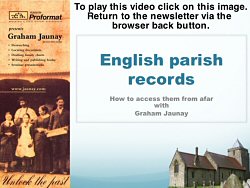You
are receiving this because your address is subscribed at: www.jaunay.com/newsletter.html |
|
 |
| No: 49 |
Mar 2010
|
|
News March Seminars 14: Family History on the Web WEA Centre Adelaide 10:00am to 1:00pm 17: Tracing your Irish ancestors Mt Barker Community Library 1:30 to 4:30pm 20: Coming to grips with FamilySearch WEA Centre Adelaide 10:00am to 1:00pm 26: Tracing your English ancestors WEA Centre Adelaide 6:30pm to 9:30pm April Seminars 8: Burnside Library FH Group 6:30pm 10: Tracing your English ancestors Huguenot Society of SA 25: Genealogy on the Web West Torrens Public Library 1:30 to 3:00pm See the seminar program for more details and bookings. Defence records seminar The NAA Adelaide Office will host a free seminar on accessing defence records 9 Mar 2010 10:00 to 11:00am. Bookings: (08) 8409 8400. Email feedback I read with interest your latest newsletter and wanted to let you know that here in Berri we were not aware of the closure of the NAA offices in Adelaide. I am involved in the library and researching and I had heard there were to be cutbacks but I was not aware of the closure. There must be many others here in the Riverland and elsewhere in SA who are also unaware of the proposed closure. Riverland history researchers use the NAA and State Records quite a bit, often staying in the city overnight to allow time to sit and research. It is enough that we need to travel to Adelaide, there are going to be a lot of sad people once they know they may need to travel to Sydney to obtain SA records! How else can we assist in getting this ridiculous decision overturned? Graham Jaunay responds: Clearly the political leaders think it is a done deal and so the time has come to look to your local Federal MP. With an election in the wind before the closure in 2011, that person may be keen to retain their seat! Write a personal letter, send a deputation to air your concerns and/or consider a petition at the local level. On the national level, the politicians can comfortably ignore petitions containing tens of thousands of names but can the local member afford to ignore a couple of hundred? What was their winning margin last election? See special newsletters 48a, 48b, 48c and 48d. A record number of responses was received as a result of the newsletter article on the closure of the Adelaide Office of the NAA. Royal Naval service records The National Archives reports that the final batch of Admiralty files from ADM139 have now been digitised. This means over 680,000 Royal Navy seamen records are now available to search and download online. Ordering LDS films A number of people have advised that their local LDS Centre no longer accepts orders for films and clients are told to order online without giving specific instructions on how to do this. You can order online at: film.familysearch.org/ |
In
this issue: |
|
Graham Jaunay Services
|
Using
directories effectively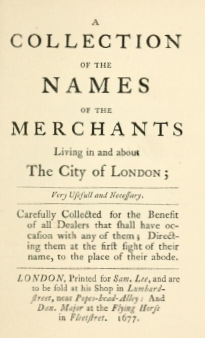 The
nineteenth century saw an explosion of a publication genre we could
loosely describe as information guides. Their popularity matched the
growing literacy of the community but in fact such publications have
a much longer history. This article is restricted to directories some
of which are better described as almanacs, gazetteers and directories.
To be included in this topic the publication must have some listing
of a section of the population. The
nineteenth century saw an explosion of a publication genre we could
loosely describe as information guides. Their popularity matched the
growing literacy of the community but in fact such publications have
a much longer history. This article is restricted to directories some
of which are better described as almanacs, gazetteers and directories.
To be included in this topic the publication must have some listing
of a section of the population.The Roger L'estrange's 1677 London Directory, A collection of the names of the Merchants living in and about the City of London, is the earliest known publication while the Sydney's 1832 New South Wales calendar and general post office directory was the first in Australia. As Roger L'estrange states on the cover of his publication—very useful and necessary. Directories were an essential tool in the daily lives of middle class people seeking products, services and locating friends and associates. As the concept developed, the simple listings were embellished with all types of information ranging from the very useful right through to useless. Very specialised directories were also developed and for the family historian probably one of the more useful English publications in this niche has to be Crockford's Clerical Directories relating to the Church of England. Family history is often all about tracing where people lived because until you hold this information it can be very difficult to locate their records and one of the most effective ways of tracing members of a family is through searching directories. The value of a directory to a researcher is very much dependent upon the compilation process used. Prior to the mid 1880s users cannot expect to find a full listing due to a number of problems faced by the publishers. This means that an omission in a directory should be considered to be just that and no more. It is dangerous to assume that the lack of an entry means that the person sought was not resident! When one considers the compilation issues faced at the time, the researcher can come to a better understanding an may even be in a position to formulate some theories as to why a particular person was not listed. The primary problem confronted by publishers in the mid part of the nineteenth century revolved around the process of obtaining information. Often there was not local precedent provided by an earlier publication and so potential entrants were not aware of such a project. Clearly citizens knowing of the existence of a directory may keep an eye out for the process to get their name in the publication. The data for early directories was gathered up by a multitude of agents and how these people acted had an obvious result on the level of accuracy of the material published. The scattered nature of early communities would also contribute to the coverage of the directory. Street numbering in Australian towns and cities was uncommon until the latter part of the nineteenth century and this could scarcely have aided the compilation process. The other significant problem faced was one of time. Most publishers attempted to have their edition circulating early in the year and as such the data collection had to take place in the prior year. Thus finding a listing in a directory can only be considered as appropriate for the previous year. Here one has to be quite careful as often short cuts were taken and names were just carried over from the previous edition if the agent had not managed to confirm the information. Some directories proclaim a level of official recognition with terms like post office and/or official in their titles. They can be found with royal coats of arms emblazoned on their covers whereas in reality these efforts were just marketing ploys and there is little evidence of such support in the earlier issues although it seems likely that much of the detailed information came from government departments and other organisations no doubt through their official publications such as the Government Gazette. When we examine Australia directories there is much evidence, often found in the directories themselves that later publications were given significant assistance by the various colonial post offices and their staff including letter-carriers. A researcher can use the Adelaide Proformat web site to locate Australian directories by year of issue and colony/state by colony/state. Before using a resource, a wise researcher needs to ascertain the reliability of the resource and thus determine a the veracity of the material. Information from a source of poor reliability needs good supporting evidence before it is considered factual. In the previous paragraphs the reliability of directories has been questioned. This doubt about accuracy should not be taken lightly. Directories were hastily compiled, only revised periodically, restricted in their coverage and scope and often relied on other publications for their content. The entries were not cross-checked and time constraints meant minimal, if any, proof reading. Mistakes are common and range from simple typos, missed household to whole pages of misinformation. The time lag between collection of data and publication is significant in those socio-economic suburbs that experience considerable mobility. Even the author's middle class families did not always own their homes and so frequently shifted address. The nature of society of the time means there is an under representation of certain classes of people and trades and occupations. Since directories only name the head of a household, servants and the like living on the premises are never included. In some sections of the community, the fear of authority, may have resulted in the provision of false names or the withholding of a name to the directory agent at the door. In Gareth Shaw's 1984 study, Directories as sources in urban history: a review of British and Canadian material, he compared the Exeter directory 1889–90 coverage with the 1891 Census to discover a 51 to 65% directory coverage (pp 40–1). Apart from errors and commissions ensure that your searching has been thorough. Consider all possible name variants and potential errors. Determine suburb name, street name, house number may have changed over time. Check that the boundaries of suburbs have not changed or that the listing may also be under broader areas such South Adelaide. As suggested elsewhere, the failure to find a listing may not be the fault of the directory. Individuals are not listed for a range of reasons: • did not wish to be listed • was not the head of the household • deceased • could not afford the listing fee • did not meet the publication deadline • outside the prerequisites of the directory content In Australia we do not have the luxury of censuses to fall back on and so we are rather more reliant on the directory. Within South Australia we cannot even expect to find an Electoral Roll our best alternative being a local government rate book and therefore directories, in spite of their limitations, are an essential resource for researchers seeking information about specific people, places and institutions at a particular time. Directories can also allow us to follow the movement of a particular family and this has been much enhanced recently by Archival Digital Books (Gould) development of searchable Australian directories published on CD/DVDs. for example, Jules Gilmour Jaunay moves about the eastern seaboard of Australia and we can follow his movements with the use of directories: 1883—Somerset Place 32 Docker Street Richmond VIC 1884—Somerset Place 32 Docker Street Richmond VIC (Sands & McDougall pp 585) 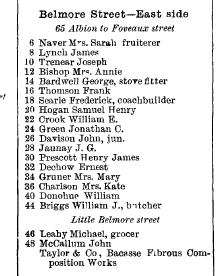 1884—74 George Street East Melbourne VIC (Sands
& McDougall pp 125; 585)
1884—74 George Street East Melbourne VIC (Sands
& McDougall pp 125; 585)1886—New Street Brighton VIC 1891—22 Fitzgerald Street South Yarra VIC 1899—Bookseller 556 Erskine Street Sydney NSW 1900-01—Ivanhoe Street Marrickville NSW 1902—28 Belmore Street Sydney NSW (Sands pp 55; 480; 1139) 1904—121 Elizabeth Street Ashfield NSW (Wise pp 124; 190; 223) 1913—Seymour Street Enfield NSW (Sands p1247) 1924—Rhyde Street Toowoomba QLD 1925-33—James Street Toowoomba QLD 1934—1935 Margaret Street Toowoomba QLD Those publications with street numbering and/or sequences lend themselves to identifying individual properties using modern street directories and the likes of Google Maps. Taking an above example, 28 Belmore Street Sydney NSW (Sands pp 55), the directory tells us that this property is located on the east side of the street between Albion and little Belmore Streets and twelve doors down from Albion Street. (see image) We can pinpoint these premises using Google Maps. We can also use these publications to develop a snapshot of lifestyle, activities and values by examining the advertisements. Those publications with street sequences lend themselves to this type of study as neighbouring properties and the occupations of the household heads are disclosed. 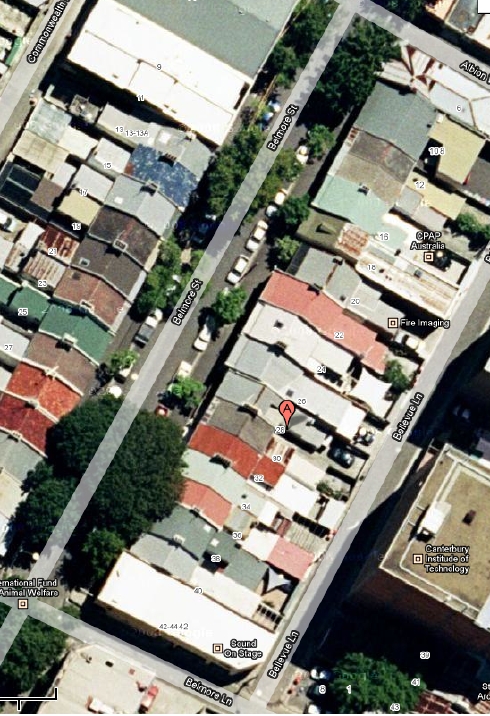 Archives closure update 
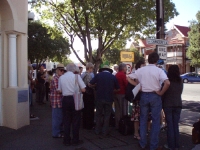 A small group of protesters gathered outside the Adelaide Office of
the National Archives on Tuesday 23 Feb 2010. The size of the group
typified the problems of the campaign to prevent the closure of this
office and those in Hobart and Darwin. The number of concerned people
are just not significant to worry any politician looking to be re-elected.
The only media present was a crew from the ABC's 7:30 Report.
A small group of protesters gathered outside the Adelaide Office of
the National Archives on Tuesday 23 Feb 2010. The size of the group
typified the problems of the campaign to prevent the closure of this
office and those in Hobart and Darwin. The number of concerned people
are just not significant to worry any politician looking to be re-elected.
The only media present was a crew from the ABC's 7:30 Report.The group was somewhat mollified with a media release form the Minister headed, Rudd Government listens on National Archives. The paper says that greater efforts will be made to establish a co-location with a similar repository. Of course this has been canvassed before and previously failed. Let's hope that the new initiative bears fruit. On 23 Feb 2010, the Minister made a statement to the Senate which can be viewed here. The protesters also received a handout from a Legislative Council Independent candidate in the approaching State Election, outlining the approaching demise of the services offered and loss of records by the SA State Library as the heritage Mortlock Wing is turned into a function centre! The 7:30 Report segment was broadcast on Tuesday, 23 Feb 2010. You can view the clip here but caution it is a large 34mB file. |
|
| To
unsubscribe send a blank email via the following link using the same
address you subscribed to: newsletter-leave@jaunay.com |
